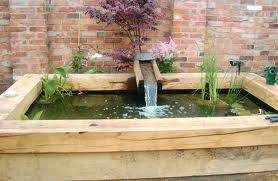





The major advantage of a raised pond is that it brings the water garden closer, allowing its inhabitants to be more readily observed and enjoyed. It is fascinating to watch the hustle and bustle of aquatic life at close quarters and in relative comfort, for if proper arrangements are made, it is possible to sit on the pond’s edge and dabble your fingers in the water.
 From a practical point of view, a raised pond will be easier to maintain because it is closer to the gardener, a tremendous advantage for anyone who is less able or of advancing years. Indeed, the construction can be arranged even to accommodate the requirements of the wheelchair gardener provided that you carefully consider this from the outset.
From a practical point of view, a raised pond will be easier to maintain because it is closer to the gardener, a tremendous advantage for anyone who is less able or of advancing years. Indeed, the construction can be arranged even to accommodate the requirements of the wheelchair gardener provided that you carefully consider this from the outset.
The major disadvantage, however, is that during severe winter weather, there is a greater danger of it freezing solid. Cold can penetrate from all sides; the temperature and conditions within a raised pond can be startlingly different from those in a pond set in the ground. Both plants and fish may suffer and, in some circumstances, the structure, too, unless precautions are taken.
A concrete raised pond can be simple to construct if it is built from ready-made, hollow concrete blocks, rather than solid concrete poured into prepared formwork or shuttering. If you want a fancy shape, of course, poured concrete is essential, but the complexities of construction are so great that you are advised to leave this job to a skilled professional.
A blockwork pond is a different proposition, although you will be restricted to a rectangular and formal style. Construction involves creating a foundation upon which to build the blocks in the same manner as a double-skinned wall (but with no gap between the skins), the inner floor area also being concreted. The inner faces of the walls are rendered with a mortar mix incorporating a waterproofing compound, while complete waterproofing is ensured by building a polythene membrane into the floor and between the inner and outer skins of the pond walls.
Ideally, the outer skin of the walls would be of brick, but this could also be of concrete blocks finished with a decorative render. A generous coping would finish off the structure and provide a pleasant place to sit. With this type of construction, shelving for marginal plants can easily be installed by building up small platforms with concrete blocks.
Of course, bricks could be employed instead of concrete blocks to build a raised pond, although they are likely to be more expensive. If you use them, make sure they are frost resistant. In fact, winter damage is more likely to occur to a concrete or brick pond than one made from any other material. If the pond freezes, the pressure exerted by the ice on such a structure can lead to fracturing, so it is essential to prevent this by floating pieces of timber or rubber balls on the water throughout the winter.
Constructing a concrete or brick wall to surround a preformed pond is another option. This has the great advantage that the pond will be watertight from the beginning, but it can be constraining in size and configuration.
A flexible pond liner could also be used inside a brick or concrete structure. The advantage of having a liner that you can see and reach is that if seepage occurs, it can easily be dealt with, even to the extent of replacing the liner.
This versatility is offset somewhat by the fact that it is not easy to install a liner in a raised structure without creases or wrinkles showing, and they will be more obvious because the liner is closer to the eye. In this case, it is worth considering a welded rubber liner, made specifically for the shape and size of the structure. In fact, using a fitted liner is one of the neatest raised pond construction methods.
Liners also allow other materials to be used for the structure, such as wood, and special kits are available that provide everything you require. Remember that a raised pond does not have to be constructed specifically as a pond; if you exercise your imagination, you may find all manner of containers that can be adapted to this use with the aid of a flexible liner.
Regardless of whether you are using concrete blocks or bricks to build your raised pond, it will be necessary to excavate an area of ground for the floor and foundations of the walls. This should be about 10cm (4in) deep and 10cm larger all round than the external dimensions of the pond. Surround the excavation by wooden boards nailed to pegs driven into the ground. The boards should he levelled with the aid of a spirit level and you should ensure that they are flush with the surrounding ground.
Line the excavation with a polythene sheet, which must be large enough that once the floor and foundation have been laid, it can he lifted on all four sides to the height of the walls. Then fill the hole with concrete, levelling it with the formwork using a long wooden hoard with a sawing motion. Cover the concrete with sacking or polythene to protect it from frost and leave for two or three days to harden fully. The concrete mix should be the same as that used for a concrete pond set in the ground.
Copyright © www.100flowers.win Botanic Garden All Rights Reserved